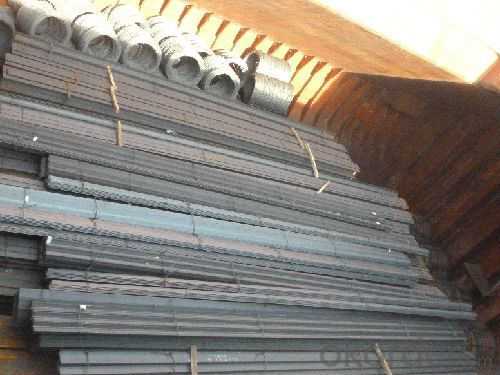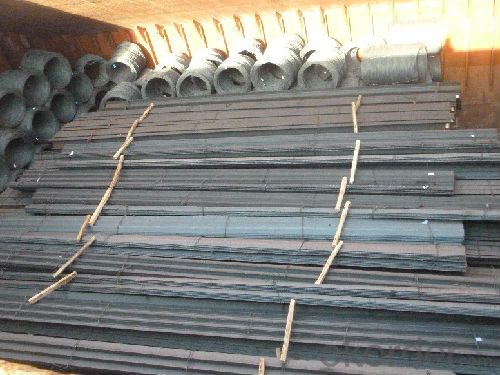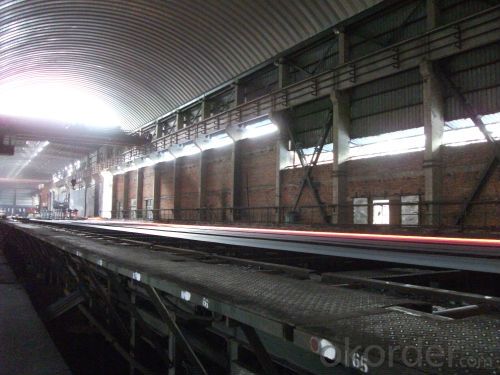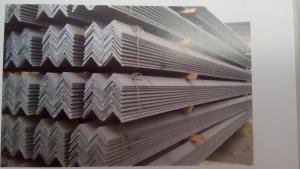Hot Rolled Steel Equal Angle Bar Unqual Angle Bar Structure Steel
- Loading Port:
- Tianjin
- Payment Terms:
- TT or LC
- Min Order Qty:
- 25 kg
- Supply Capability:
- 30000 kg/month
OKorder Service Pledge
OKorder Financial Service
You Might Also Like
Product Description:
OKorder is offering Hot Rolled Steel Equal Angle Bar Unqual Angle Bar Structure Steel at great prices with worldwide shipping. Our supplier is a world-class manufacturer of steel, with our products utilized the world over. OKorder annually supplies products to European, North American and Asian markets. We provide quotations within 24 hours of receiving an inquiry and guarantee competitive prices.
Product Applications:
Hot Rolled Steel Equal Angle Bar Unqual Angle Bar Structure Steel are ideal for structural applications and are widely used in the construction of buildings and bridges, and the manufacturing, petrochemical, and transportation industries.
Product Advantages:
OKorder's Hot Rolled Steel Equal Angle Bar Unqual Angle Bar Structure Steel are durable, strong, and resist corrosion.
Main Product Features:
· Premium quality
· Prompt delivery & seaworthy packing (30 days after receiving deposit)
· Corrosion resistance
· Can be recycled and reused
· Mill test certification
· Professional Service
· Competitive pricing
Product Specifications:
Specifications of Angle Steel
1. Invoicing on theoretical weight or actual weight as customer request
2. Length: 6m, 9m, 12m as following table
3. Sizes
Sizes: 25mm-250mm | ||
a*t | ||
25*2.5-4.0 | 70*6.0-9.0 | 130*9.0-15 |
30*2.5-6.6 | 75*6.0-9.0 | 140*10-14 |
36*3.0-5.0 | 80*5.0-10 | 150*10-20 |
38*2.3-6.0 | 90*7.0-10 | 160*10-16 |
40*3.0-5.0 | 100*6.0-12 | 175*12-15 |
45*4.0-6.0 | 110*8.0-10 | 180*12-18 |
50*4.0-6.0 | 120*6.0-15 | 200*14-25 |
60*4.0-8.0 | 125*8.0-14 | 250*25 |
Packaging & Delivery of Angle Steel
1. Packing: it is nude packed in bundles by steel wire rod
2. Bundle weight: not more than 3.5MT for bulk vessel; less than 3 MT for container load
3. Marks:
Color marking: There will be color marking on both end of the bundle for the cargo delivered by bulk vessel. That makes it easily to distinguish at the destination port.
Tag mark: there will be tag mark tied up on the bundles. The information usually including supplier logo and name, product name, made in China, shipping marks and other information request by the customer.
If loading by container the marking is not needed, but we will prepare it as customer request.
FAQ:
Q1: Why buy Materials & Equipment from OKorder.com?
A1: All products offered byOKorder.com are carefully selected from China's most reliable manufacturing enterprises. Through its ISO certifications, OKorder.com adheres to the highest standards and a commitment to supply chain safety and customer satisfaction.
Q2: How do we guarantee the quality of our products?
A2: We have established an advanced quality management system which conducts strict quality tests at every step, from raw materials to the final product. At the same time, we provide extensive follow-up service assurances as required.
Q3: How soon can we receive the product after purchase?
A3: Within three days of placing an order, we will begin production. The specific shipping date is dependent upon international and government factors, but is typically 7 to 10 workdays.
Q4: What makes stainless steel stainless?
A4: Stainless steel must contain at least 10.5 % chromium. It is this element that reacts with the oxygen in the air to form a complex chrome-oxide surface layer that is invisible but strong enough to prevent further oxygen from "staining" (rusting) the surface. Higher levels of chromium and the addition of other alloying elements such as nickel and molybdenum enhance this surface layer and improve the corrosion resistance of the stainless material.
Q5: Can stainless steel rust?
A5: Stainless does not "rust" as you think of regular steel rusting with a red oxide on the surface that flakes off. If you see red rust it is probably due to some iron particles that have contaminated the surface of the stainless steel and it is these iron particles that are rusting. Look at the source of the rusting and see if you can remove it from the surface.
Images:



- Q:What are steel angles used for?
- Steel angles are commonly used in construction and engineering applications for providing structural support, reinforcing corners, framing, and bracing various structures such as buildings, bridges, and machinery.
- Q:Are steel angles suitable for load-bearing walls?
- Yes, steel angles can be suitable for load-bearing walls. Steel angles are commonly used in construction for their structural strength and stability. They are designed to bear heavy loads and provide support to the walls. Steel angles are often used as lintels above doors and windows to transfer the load from above to the surrounding walls. They can also be used as vertical supports in walls to bear the weight of the floors and roof. However, it is important to consult with a structural engineer or a professional builder to determine the appropriate size and placement of steel angles for load-bearing walls, as the specific requirements may vary depending on the building design and load conditions.
- Q:How are steel angles protected against rusting?
- Steel angles are protected against rusting through a process known as galvanization. Galvanizing involves coating the steel angles with a layer of zinc. This zinc coating acts as a barrier between the steel and the surrounding environment, preventing moisture and oxygen from coming into contact with the steel surface. As a result, the steel angles are protected from rusting. Galvanized steel angles are commonly used in outdoor applications or in environments where they may be exposed to moisture, such as in construction, infrastructure, or manufacturing industries. Additionally, regular maintenance and proper storage of steel angles can also help prolong their protection against rusting.
- Q:Are steel angles resistant to chemicals?
- Yes, steel angles are generally resistant to chemicals due to their high durability and corrosion resistance. However, their resistance may vary depending on the specific type of chemical and environment they are exposed to.
- Q:How do steel angles perform in corrosive gas or liquid environments?
- The strength and versatility of steel angles make them a popular choice for various structural applications. However, their performance in corrosive gas or liquid environments can be impacted by the grade of steel used and the concentration and nature of the corrosive substance. When exposed to corrosive gases or liquids, steel angles can undergo corrosion, leading to a gradual deterioration of their structural integrity. The extent of corrosion depends on factors such as exposure time, temperature, humidity, and the corrosiveness of the gas or liquid. To counteract the effects of corrosion, protective coatings can be applied to steel angles used in corrosive environments. Examples of common protective coatings include galvanization, which involves adding a layer of zinc to the steel surface, as well as epoxy or polyurethane coatings. These coatings create a barrier that prevents direct contact between the corrosive substance and the steel, thereby slowing down the corrosion process. However, it is important to acknowledge that even with protective coatings, steel angles may still experience some level of corrosion over time. The extent of corrosion will depend on the quality and durability of the coating, as well as the regular maintenance and inspection of the steel angles. In extremely aggressive or highly concentrated corrosive environments, steel angles may not be the most suitable choice. In such cases, alternative materials like stainless steel or corrosion-resistant alloys may be more appropriate. In conclusion, the performance of steel angles in corrosive gas or liquid environments is influenced by specific conditions and protective measures in place. Regular inspection, proper maintenance, and the use of suitable coatings are vital for ensuring the longevity and performance of steel angles in corrosive environments.
- Q:Can steel angles be used for transportation infrastructure projects?
- Indeed, transportation infrastructure projects can make use of steel angles. The construction industry frequently relies on steel angles for a range of purposes, including the development of bridges, highways, and railways. These angles offer vital support and stability to such structures, ensuring their strength and durability. Their versatility allows for easy fabrication and installation, making them an excellent selection for transportation infrastructure projects that prioritize strength and dependability. Moreover, steel angles possess a remarkable load-bearing capacity and resistance to environmental elements, guaranteeing the long-term safety and longevity of transportation infrastructure. As a result, steel angles find extensive use in transportation infrastructure projects across the globe.
- Q:Can steel angles be used for handrails?
- Yes, steel angles can be used for handrails. Steel angles are often used as a structural component for handrails due to their strength and durability. They can provide a sturdy and stable support for handrails in various applications.
- Q:Are steel angles suitable for earthquake-prone areas?
- Due to their exceptional structural properties, steel angles find widespread use in construction, especially in areas prone to earthquakes. The L-shaped configuration of steel angles imparts significant stability and strength, rendering them ideal for withstanding seismic forces. Renowned for their high tensile strength and resistance to bending and twisting, steel angles play a vital role in earthquake situations. Moreover, steel is a ductile material capable of undergoing substantial deformation without failing, thereby absorbing a portion of the seismic energy generated. This flexibility effectively prevents catastrophic structural collapse during earthquakes. Additionally, steel angles can be easily fastened together through bolting or welding, ensuring efficient and cost-effective construction processes. Nonetheless, it is crucial to emphasize that the design and construction of structures in earthquake-prone areas must adhere to local building codes and regulations to guarantee maximum safety.
- Q:What are the different types of connections used for steel angles in industrial applications?
- Steel angles are commonly employed in industrial applications for various structural purposes. To ensure their stability and strength, different types of connections are utilized. The following are some of the diverse connection methods used for steel angles in industrial applications: 1. Welded Connections: In industrial applications, welding is widely utilized to connect steel angles. This method involves melting the edges of two steel angles together and allowing them to solidify, resulting in a permanent and robust connection. Welded connections offer exceptional strength and durability, making them suitable for heavy-duty applications. 2. Bolted Connections: To secure steel angles, bolted connections involve the use of bolts and nuts. Typically, holes are drilled into the angles, and bolts are inserted through these holes, which are then tightened using nuts. Bolted connections have the advantage of being easily dismantled and modified, making them suitable for applications that require frequent adjustments or repairs. 3. Riveted Connections: Although less commonly used in modern industrial applications, riveting is a traditional method for connecting steel angles. Riveted connections involve inserting a rivet through holes in the steel angles and deforming the rivet to secure the angles together. While riveted connections offer good strength, they are time-consuming and require specialized equipment. 4. Clip Connections: Clip connections involve the use of metal clips or brackets to connect steel angles. These clips are typically bolted or welded to the steel angles, providing a secure connection. Clip connections are often employed in applications where quick and easy assembly and disassembly are required, such as temporary structures. 5. Gusset Plate Connections: Gusset plates, which are thin steel plates, are used to connect steel angles in industrial applications. These plates are usually bolted or welded to the steel angles, providing additional strength and stability. Gusset plate connections are commonly utilized in applications where higher loads or forces are expected. It is important to note that the choice of connection method for steel angles in industrial applications depends on various factors, including load requirements, structural design, ease of assembly and disassembly, and the expected lifespan of the structure.
- Q:What are the different methods of surface painting for steel angles?
- There are several different methods of surface painting for steel angles, including brush painting, spray painting, and powder coating. Brush painting involves applying paint directly onto the surface using a brush or roller. Spray painting uses a paint gun to evenly distribute paint onto the surface. Powder coating involves applying a dry powder to the steel angle and then curing it in a high-temperature oven, resulting in a durable and long-lasting finish.
1. Manufacturer Overview |
|
|---|---|
| Location | |
| Year Established | |
| Annual Output Value | |
| Main Markets | |
| Company Certifications | |
2. Manufacturer Certificates |
|
|---|---|
| a) Certification Name | |
| Range | |
| Reference | |
| Validity Period | |
3. Manufacturer Capability |
|
|---|---|
| a)Trade Capacity | |
| Nearest Port | |
| Export Percentage | |
| No.of Employees in Trade Department | |
| Language Spoken: | |
| b)Factory Information | |
| Factory Size: | |
| No. of Production Lines | |
| Contract Manufacturing | |
| Product Price Range | |
Send your message to us
Hot Rolled Steel Equal Angle Bar Unqual Angle Bar Structure Steel
- Loading Port:
- Tianjin
- Payment Terms:
- TT or LC
- Min Order Qty:
- 25 kg
- Supply Capability:
- 30000 kg/month
OKorder Service Pledge
OKorder Financial Service
Similar products
New products
Hot products
Related keywords




























